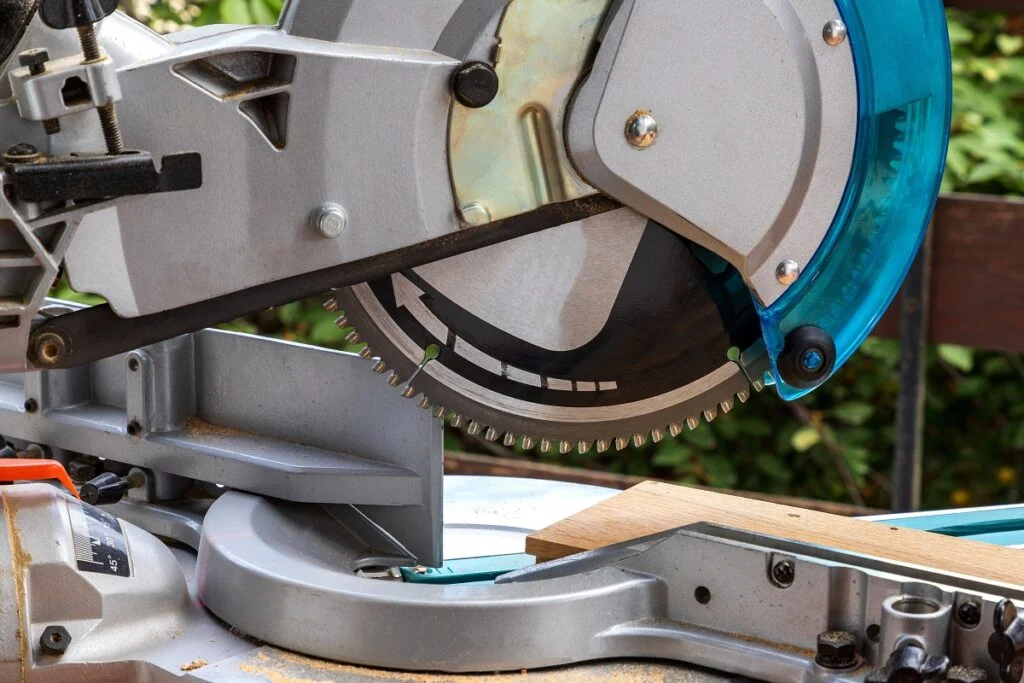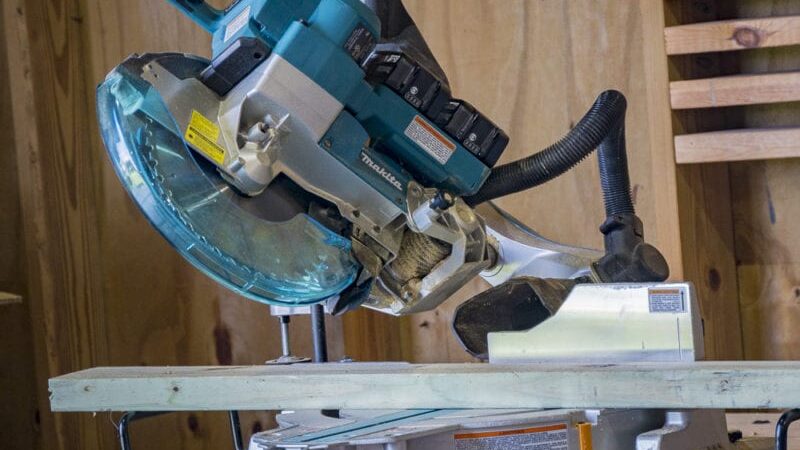Picking the right instrument can significantly affect woodworking and DIY projects. Two popular options often come up in the debate are the miter saw and the jigsaw. Both tools have unique features and capabilities, making them suitable for cutting tasks.
In this discussion, we’ll explore the world of miter saw vs. jigsaw, comparing their strengths and weaknesses to help you make an informed choice for your next project.
What is a Miter Saw?
A miter saw, sometimes called a chop saw or drop saw, is a specialized power tool designed for making precise and accurate crosscuts and miter cuts in various materials, primarily wood, plastic, or metal, depending on the blade used.
The critical components of a miter saw include:
- A roundabout saw cutting edge mounted on a turning arm.
- A miter scale for angle adjustments.
- A bevel adjustment for making bevel cuts.
- A fence for stability and guidance.
- Often a work clamp to secure the material during cutting.
Miter saws are regularly utilized in carpentry and development for tasks like cutting trim, baseboards, crown molding, and framing components with angled or straight cuts. They are known for making highly accurate cuts at specific angles, essential for achieving tight-fitting joints and professional-looking results.
Different types of miter saws are available, including basic miter saws, compound miter saws, and sliding compound miter saws, each offering varying degrees of versatility and capability in making cuts. Miter saws are valued for their precision, speed, and efficiency in handling repetitive cutting tasks, making them an essential tool in many workshops and job sites.
What is a Jigsaw?
A jigsaw is a versatile and handheld power tool used primarily for making curved and intricate cuts in different materials, including wood, plastic, metal, and even ceramics.
The critical components of a jigsaw include:
- A handle for gripping and controlling the tool.
- A base or shoe that provides stability and support during cutting.
Jigsaws are known for their maneuverability and ability to cut along curved lines, irregular shapes, and intricate patterns. The blade’s design allows it to make straight cuts and curves, making it a valuable tool for cutting out holes for electrical outlets, creating custom shapes in woodwork, and cutting curves in plywood or metal sheets.
Key features of a jigsaw may include:
- Variable speed settings.
- Orbital action for faster cutting in wood.
- Adjustable base angles for bevel cuts.
- Toolless blade change systems for convenience.
Jigsaws are widely used in woodworking, DIY projects, metalworking, and various construction applications due to their versatility and precision in making detailed and creative cuts.
Critical Differences Between Miter Saw and Jigsaw
Miter saws and jigsaws are valuable cutting tools, but they have distinct differences and different purposes. Here are the key differences between a miter saw and a jigsaw:

Cutting Capability:
- Miter Saw: Miter saws are primarily designed for making straight crosscuts and angled miter cuts in materials like wood, plastic, and certain metals. They excel at making precise, square cuts and are less suitable for curved or intricate cuts.
- Jigsaw: Jigsaws are versatile for making curved, intricate, and irregular cuts. They are ideal for cutting shapes, curves, and patterns in various materials, including wood, plastic, metal, and ceramics.
Cutting Precision:
- Miter Saw: Miter saws are known for their high precision and accuracy, making them excellent for tasks that require tight-fitting joints and square cuts.
- Jigsaw: Jigsaws offer good accuracy but may have a different precision than miter saws, especially for straight cuts. They excel at following curves and lines.
Cutting Depth:
- Miter Saw: Miter saws have limited cutting depth and are primarily used for making cuts through the thickness of materials, such as boards and molding.
- Jigsaw: Jigsaws have greater cutting depth versatility, allowing them to cut through thicker materials, such as plywood, by adjusting the blade length.
Cutting Angles:
- Miter Saw: Miter saws can make angled miter cuts, typically used for corner joints, but they do not make curved or intricate cuts.
- Jigsaw: Jigsaws are designed for cutting curves and angles, offering flexibility for various cutting patterns and shapes.
Portability:
- Miter Saw: Miter saws are stationary tools and are less portable. They are typically used in workshops or job sites.
- Jigsaw: Jigsaws are handheld and much more portable, allowing you to take them to different locations and use them for on-site or DIY projects.
Versatility:
- Miter Saw: Miter saws specialize in specific cutting tasks, primarily crosscuts and miter cuts. They need to gain the versatility to handle complex shapes and curves.
- Jigsaw: Jigsaws are versatile and can handle various cutting tasks, including intricate shapes, curves, and straight cuts, making them suitable for various applications.
Workpiece Size:
- Miter Saw: Miter saws are typically used for cutting smaller to medium-sized workpieces, such as boards and trim.
- Jigsaw: Jigsaws can cut small and large workpieces, making them suitable for a broader range of projects.
Miter saws and jigsaws have different strengths and applications. Miter saws excel at making precise straight and angled cuts in materials like wood, while jigsaws are versatile tools designed for cutting curves, intricate patterns, and various materials. The choice between the two depends on the specific cutting needs of your project.
Cutting Capacity
The maximum cutting capacity of miter saws and jigsaws differs significantly due to their design and intended use. Here’s a comparison of their cutting capacities:
Miter Saw:
- Crosscuts: Miter saws are designed primarily for making straight crosscuts across the width of a workpiece. The diameter of the saw blade determines the maximum cutting capacity in terms of width. Standard miter saw blade sizes include 8, 10, and 12 inches, with larger blades providing greater cutting capacity. For example, a 10-inch miter saw can typically cut a board up to 5.5 inches wide in a single pass.
- Depth of Cut: Miter saws are not designed for deep cuts through the thickness of a material. They excel at making cuts through the width of materials like boards, molding, and trim. The depth of cut is limited to the vertical movement of the saw blade, which is typically around 2 to 4 inches, depending on the saw’s design.
Jigsaw:
- Curved and Intricate Cuts: Jigsaws are versatile for making curved, intricate, and irregular cuts in various materials. The maximum cutting capacity of a jigsaw is primarily determined by the thickness of the material rather than its width.
- Depth of Cut: Jigsaws can cut through thicker materials than miter saws. The depth of cut varies among jigsaw models but can range from around 2 to 4 inches or more, depending on the jigsaw’s power and blade length. This allows jigsaws to cut through thicker materials like plywood, countertops, and metal sheets.
Miter saws have a larger cutting capacity in width and are designed for making straight crosscuts in materials up to a specific width and thickness. On the other hand, jigsaws are more versatile when cutting through thicker materials and excel at making curved and intricate cuts.
The choice between the two tools should be based on the specific cutting needs of your project, considering both the material’s thickness and the desired cut type.
The Versatility of Miter Saws and Jigsaws
Miter saws and jigsaws are versatile power tools, but they offer versatility in different ways due to their distinct cutting capabilities. Here’s a closer look at the versatility of each tool:

The Versatility of Miter Saws:
- Accurate Crosscuts and Miter Cuts: Miter saws are exceptional in making accurate crosscuts and miter cuts in materials like wood, plastic, and certain metals. They are the go-to choice for precise 90-degree cuts and angled cuts, making them invaluable for tasks like framing, trim work, and crown molding installation.
- Bevel Cuts: Many miter saws, especially compound and sliding compound models, can make bevel cuts. This adds versatility by allowing you to cut at an angle through the thickness of the material, which is helpful for tasks like creating beveled edges and joints.
- Cuts at Different Angles: Miter saws provide flexibility in adjusting the cutting angle, often ranging from -45 to +45 degrees or more, depending on the model. This versatility is crucial for various cutting patterns and joining methods.
- Repeatable and Precise Cuts: Miter saws excel at making repeatable and precise cuts, which are essential for achieving professional-quality results in woodworking and construction projects.
- Suitable for Straight Cuts: While miter saws specialize in angled cuts, they can also make accurate straight cuts, making them versatile for various applications.
Versatility of Jigsaws:
- Curved and Intricate Cuts: Jigsaws are unparalleled in cutting curves, intricate patterns, and irregular shapes. They offer the freedom to create artistic and custom designs in wood, plastic, metal, and ceramics.
- Variable Speed and Blade Options: Many jigsaws have variable speed settings and various blade options, including specialized blades for different materials. This versatility makes them adaptable to different cutting challenges.
- Portability: Jigsaws are handheld and highly portable. Their mobility allows you to take them to job sites or move around a workshop quickly, making them versatile for on-site and DIY projects.
- Depth Adjustment: Jigsaws often have an adjustable cutting depth, allowing them to cut through various material thicknesses. This feature enhances their versatility for cutting tasks.
- Mitering Capability: Some jigsaws have a tilting base or adjustable shoe, allowing for limited mitering capability, although less expensive than miter saws.
When to Use a Miter Saw?
A miter saw finds its place in various woodworking and construction scenarios, offering unmatched precision and efficiency. Its primary role lies in trim carpentry, where it excels at cutting materials like baseboards, crown molding, and door casing, ensuring perfectly square joints and seamless corners. In framing, crafting lumber into the precise lengths and angles needed for framing members becomes indispensable.
Cabinet-making benefits from the miter saw’s ability to create exact cuts for cabinet frames, doors, and drawers. Whether crafting custom furniture shelves or engaging in woodworking projects, this tool quickly guarantees clean crosscuts, bevel cuts, and compound cuts. Crown molding installation, deck building, picture framing, renovation, and remodeling all lean on the miter saw for accuracy in creating professional finishes.
Even DIY enthusiasts find miter saws invaluable for crafting outdoor furniture garden structures and tackling home improvement tasks. However, it’s essential to remember that miter saws excel at square and angled cuts, not intricate or curved ones, and selecting the right blade for the material is crucial for optimal results.
When to Use a Jigsaw?
The jigsaw, a versatile and maneuverable power tool, is helpful in many cutting scenarios. Its forte is crafting curved cuts in wood, plywood, plastic, and even metals, making it indispensable for creating custom shapes and patterns.
The jigsaw excels when holes need to be cut for electrical outlets, sink cutouts in countertops, or vents in ductwork. Intricate interior cutouts within materials, such as cabinet backs or ornate scrollwork in wood, become achievable feats with this tool. Woodworkers harness its capabilities for crafting detailed designs, inlays, and decorative patterns in wooden projects.
While not the primary choice for metal cutting, jigsaws equipped with specialized blades can tackle thin metal sheets and pipes. They also prove handy for shaping plastic pipes and panels. Ceramic tile cutting is made precise with the right blade. DIY enthusiasts rely on jigsaws for various projects, from building furniture to creating unique decorations.
Artists and artisans employ the jigsaw’s versatility in crafting custom artwork, wooden sculptures, and other creative endeavors. The jigsaw’s ability to make intricate and curved cuts across diverse materials and its portability and versatility position it as an invaluable tool for achieving detailed and creative results in various applications.
Cost and Budget
There’s a significant range to keep in mind regarding the cost and budget considerations for miter saws and jigsaws. Miter saws, renowned for their precision in making crosscuts and miter cuts, offer options for various budgets. Basic miter saws are budget-friendly, from around $100 to $200, ideal for occasional DIY projects.
Mid-range miter saws, with larger blades and additional features, can be found in the $200 to $500 range, striking a balance between price and versatility. On the other hand, high-end professional-grade miter saws, priced from $500 to $1,000 or more, cater to experienced woodworkers and contractors tackling complex tasks.
When it comes to jigsaws, the cost landscape is also diverse. Entry-level jigsaws, suitable for simple cutting tasks, begin at roughly $30 to $50, making them budget-friendly options for DIY enthusiasts. Mid-range jigsaws, offering improved features, typically fall within the $50 to $150 range, providing a good mix of performance and affordability. Premium jigsaws boasting advanced features.
Ultimately, your budget for these tools should align with your specific project needs and the frequency of use. Casual DIYers may find basic or mid-range options sufficient, while professionals and those tackling demanding projects may benefit from investing in higher-quality tools. Features and capabilities should guide your decision, ensuring your chosen saw meets your intended use and budget constraints.
Which One Is Best Among the Miter Saw and Jigsaw?
The choice between a miter saw and a jigsaw depends on your specific needs and the type of woodworking or cutting tasks you plan to perform. These two tools serve different purposes, so it’s essential to understand their differences and consider your project requirements before determining which one is best for you:
Miter Saw:

- Purpose: Miter saws are designed for making precise crosscuts and miter cuts in wood, metal, or other materials. They excel at making straight and angled cuts quickly and accurately.
- Common Uses: Miter saws are often used for framing, trim work, crown molding, and other tasks that require precise and repeatable angled cuts.
- Accuracy: Miter saws provide excellent accuracy for square and angled cuts.
- Limitations: Miter saws are not suitable for curved cuts or intricate designs. They are also bulkier and less versatile than jigsaws.
Jigsaw (or Jig Saw):
- Purpose: Jigsaws are versatile cutting tools for making curved, intricate shapes and plunge cuts in various materials, including wood, plastic, metal, and more.
- Common Uses: Jigsaws are ideal for tasks like cutting out patterns, curves, holes for sink installations, and other irregular cuts that require maneuverability.
- Accuracy: While jigsaws can be accurate, they may provide a different level of precision than miter saws for straight or angled cuts.
- Limitations: Jigsaws are less suited for making long, straight cuts or achieving precise mitered angles.
The choice between a miter saw and a jigsaw depends on the nature of your project and the types of cuts you need to make. If you primarily need to make straight or angled cuts with precision, a miter saw is the better choice. On the other hand, if your work involves curved or irregular cuts, intricate designs, or cutting out shapes, a jigsaw is more appropriate. Many woodworkers and DIY enthusiasts have tools in their workshops to cover a wide range of cutting tasks.
Conclusion
Choosing between a miter saw and a jigsaw usually depends on your woodworking or cutting needs. Both tools have their distinct advantages and limitations. The miter saw excels at making accurate crosscuts, miter cuts, and bevel cuts in larger workpieces, offering precision and efficiency in tasks like framing and trim work.
On the other hand, the jigsaw is a versatile handheld tool that shines in tasks requiring curved cuts, intricate designs, and maneuverability, making it ideal for projects like detailed scrollwork and cutting irregular shapes.
To make the right choice, consider the nature of your project, the type of cuts required, available workspace, and your budget. Both tools in your workshop can give the flexibility expected to handle a wide variety of woodworking and DIY tasks effectively. Ultimately, deciding between a miter saw and a jigsaw should align with your specific project requirements and your overall woodworking goals.

